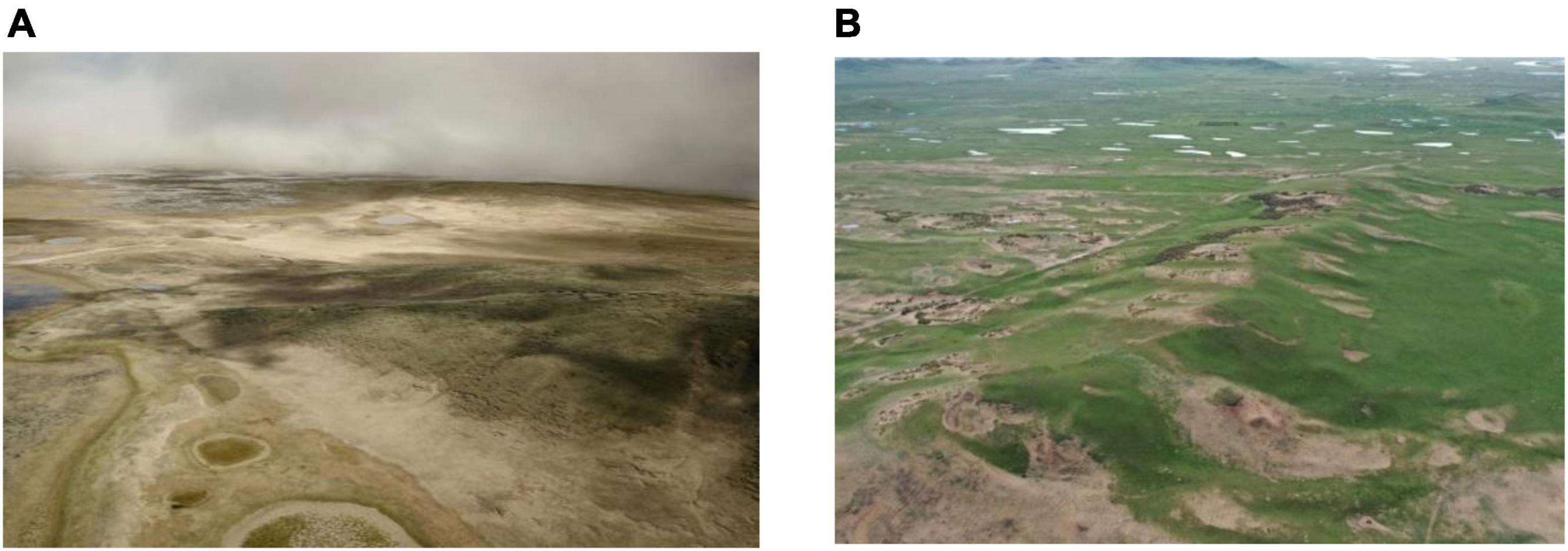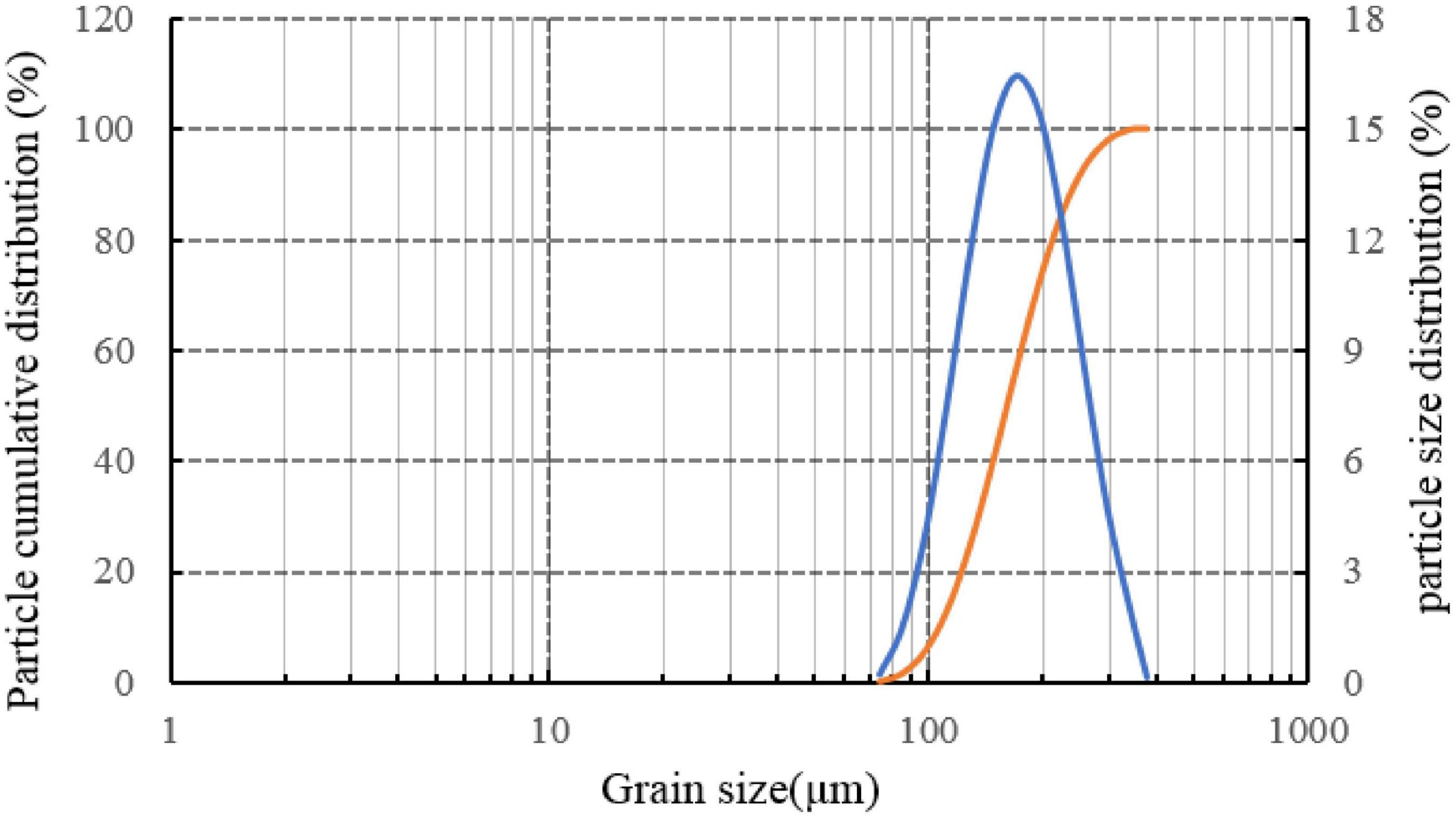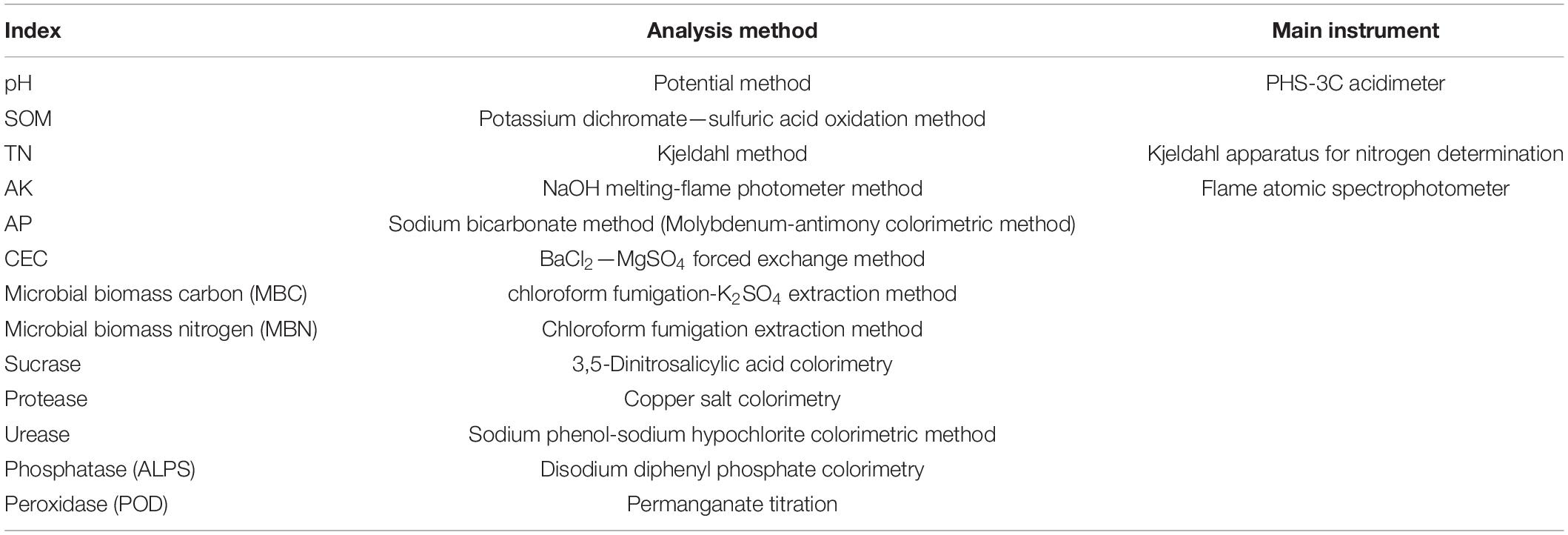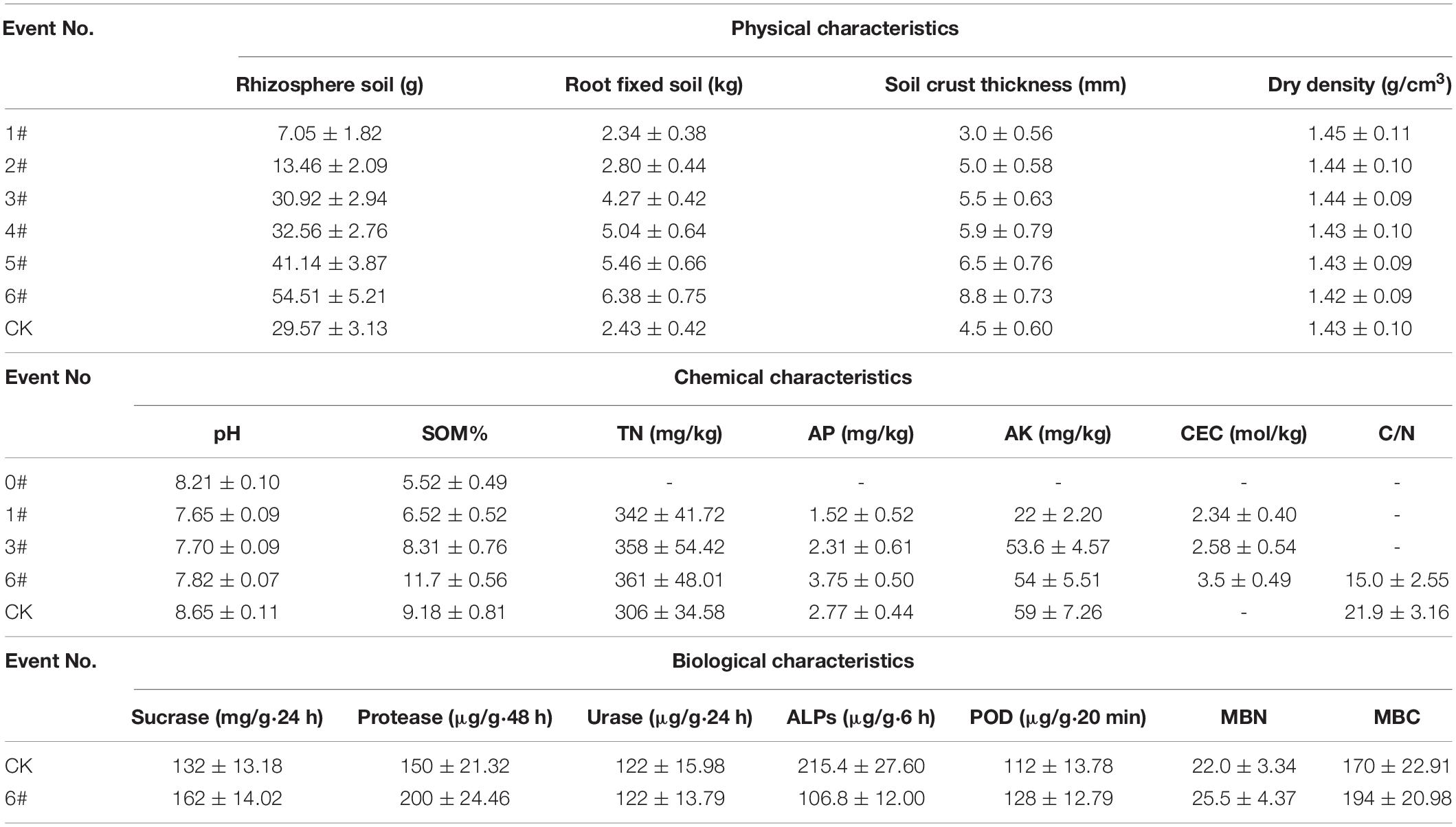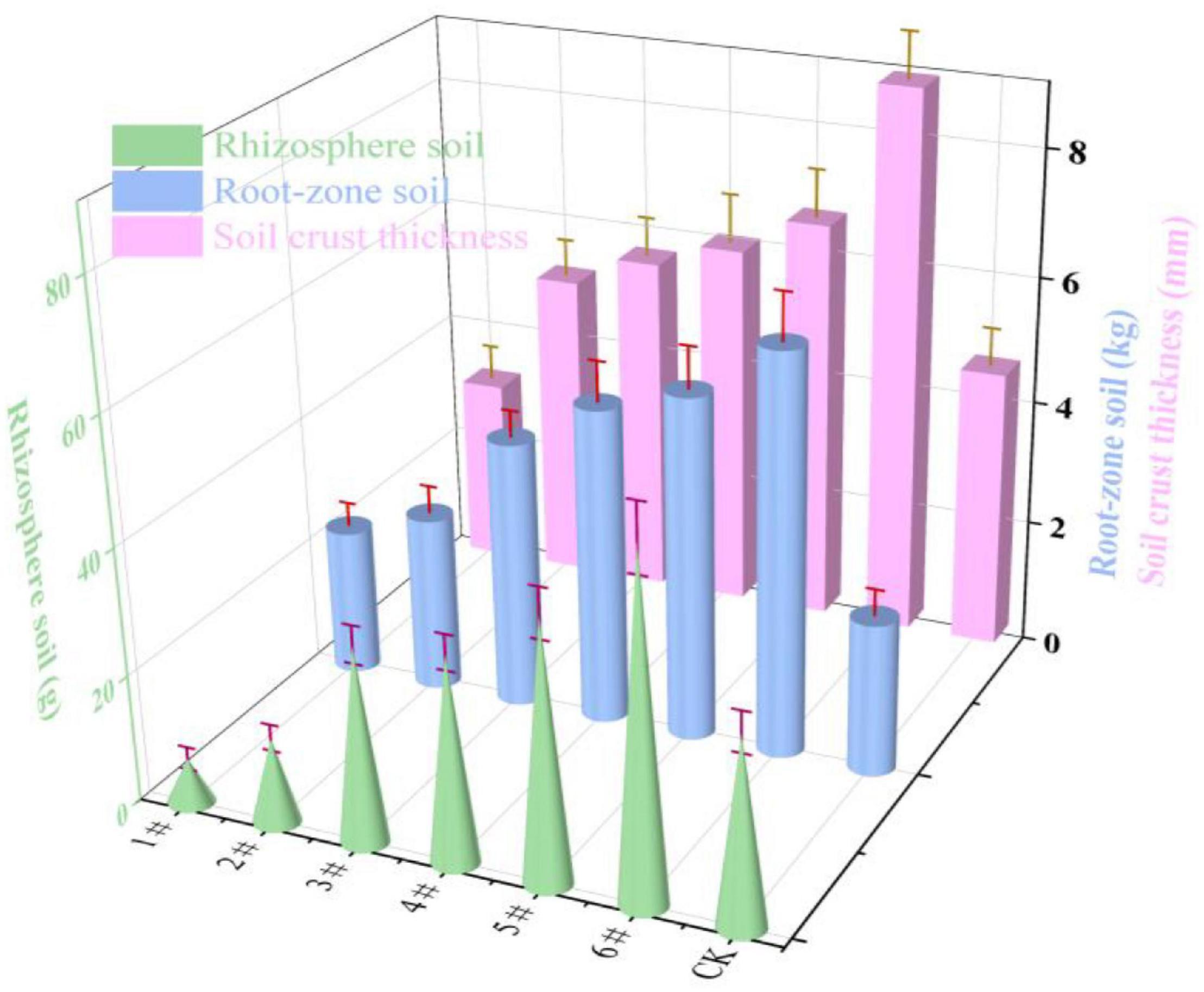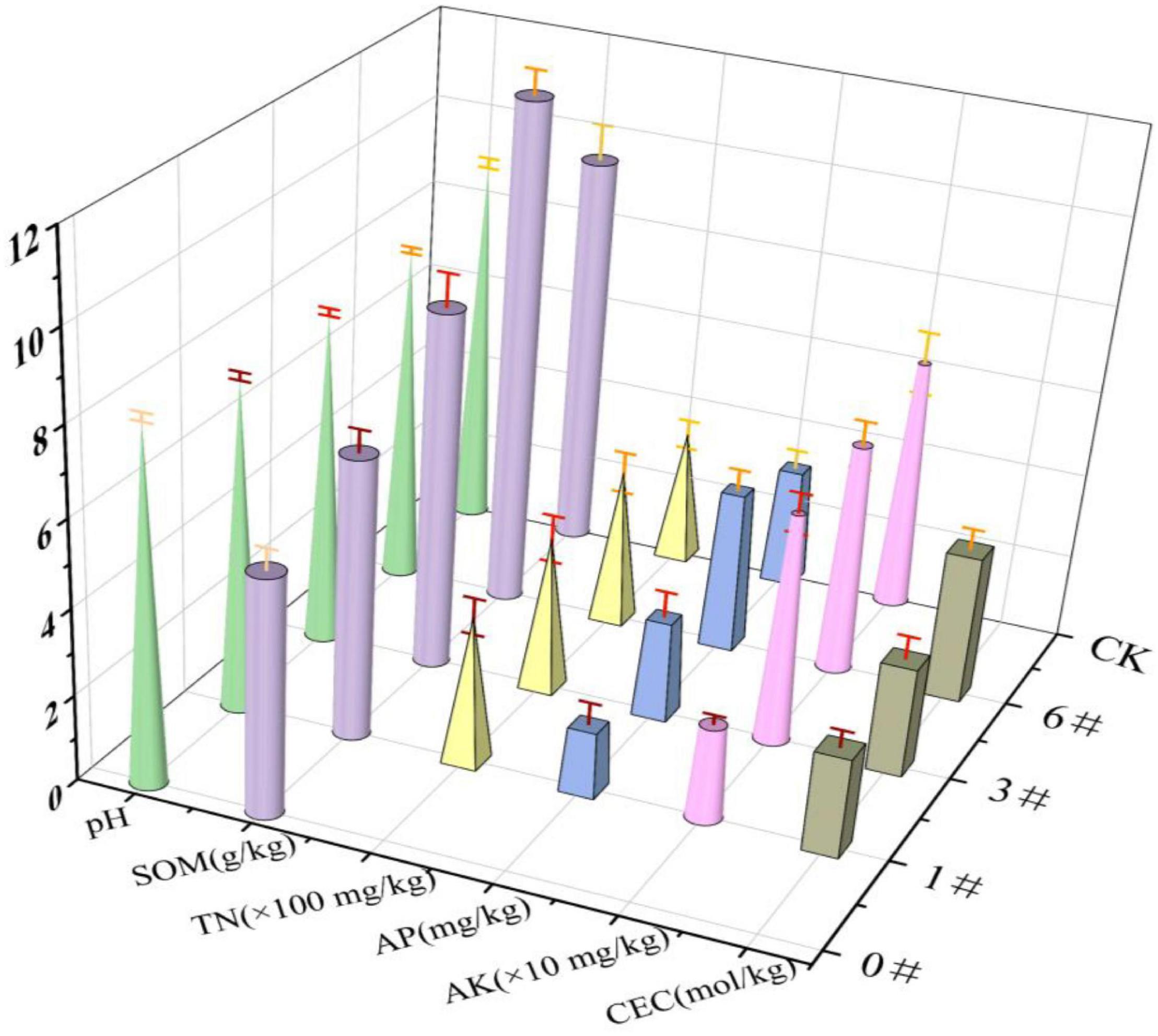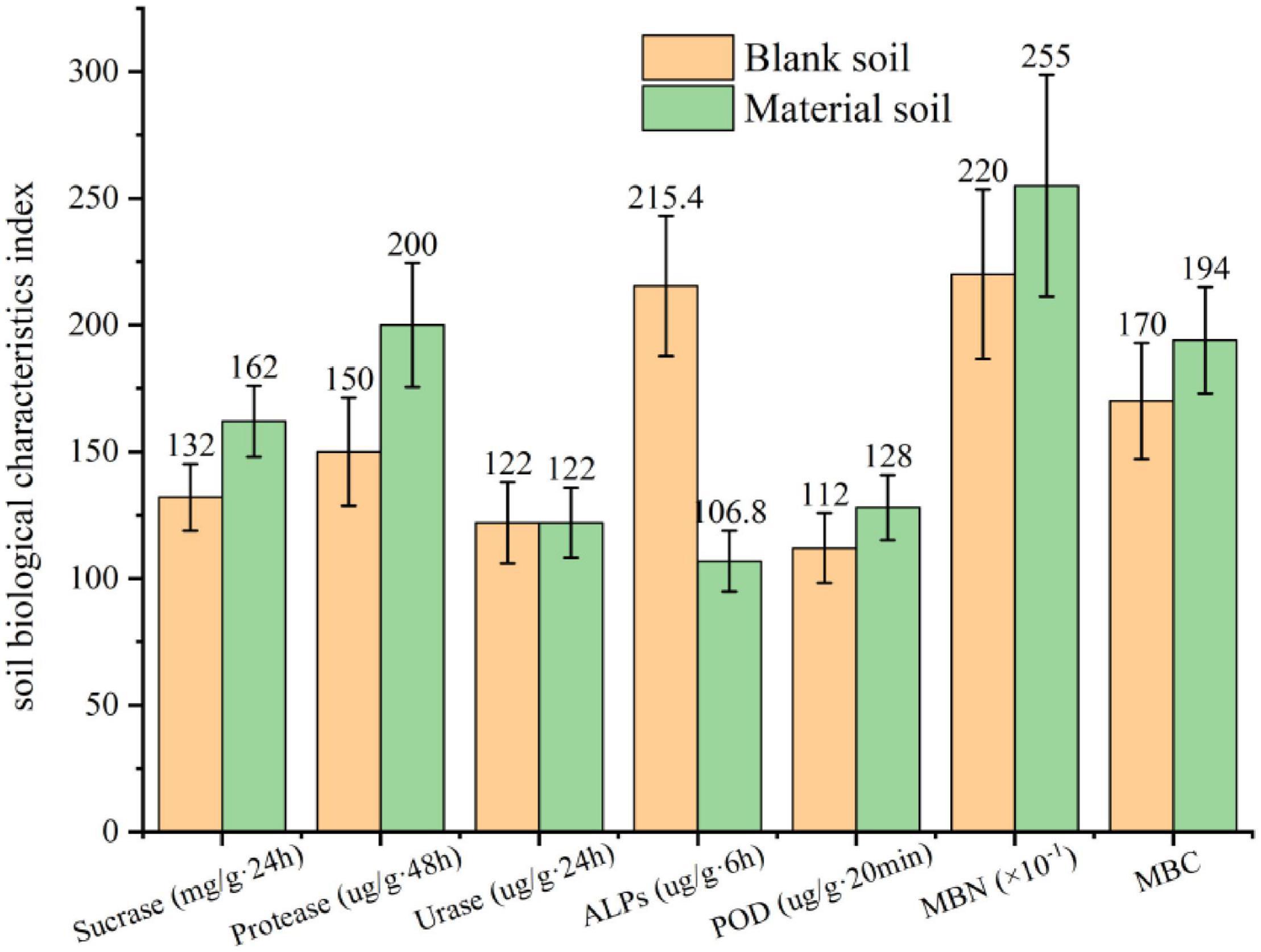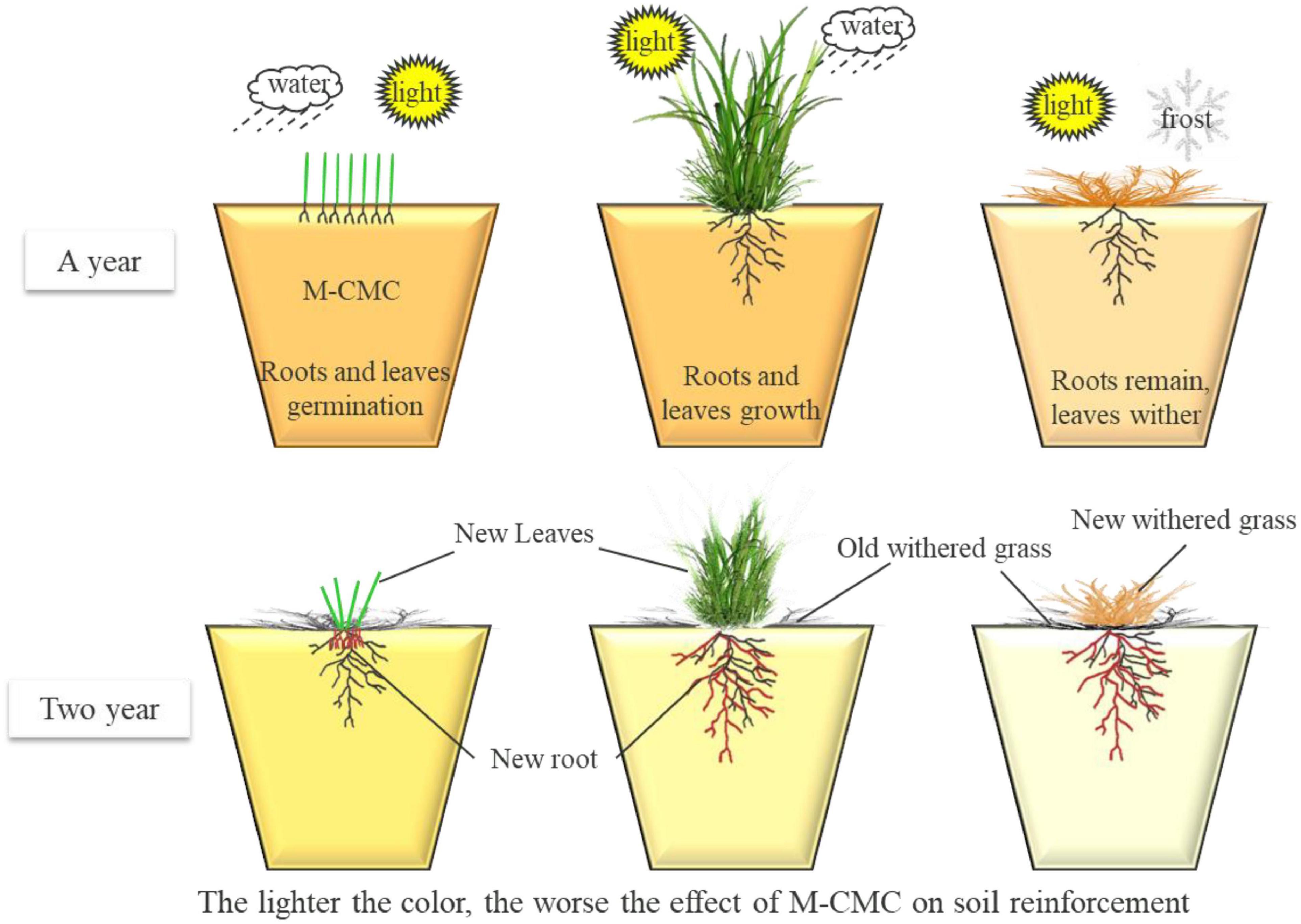- 1State Key Laboratory of Geohazard Prevention and Geoenvironment Protection, Chengdu University of Technology, Chengdu, China
- 2Post – Doc Research Station of Civil Engineering, Chengdu University of Technology, Chengdu, China
- 3College of Environment and Civil Engineering, Chengdu University of Technology, Chengdu, China
Serious desertification problems were found in alpine grassland of the Qinghai-Tibet Plateau, China. The rehabilitation progress of degraded grassland is slow under natural conditions that have low rainfall and large evaporation. Organic agent-solidified soil is one of the most important measurements that limit desertification and grassland conservation-restoration. However, the characteristics of vegetation growth and development in solidified soil need to be studied in depth. This research is based on the modified carboxymethyl cellulose (MCMC) of independent development. Based on the sand soil taken from moving sandy land of Zoige, potted plants were tested in the environmental chamber at the laboratory. The physical, chemical, and biological characteristics of root soil were monitored for more than 7 months. As a result, the plant biomass in the experimental group increased, lodging rate decreased, drought tolerance and survival rate increased, and the number of plant roots and root surface area index, root cross-sectional area ratio, and root volume ratio increased compared with the matched group. It is shown that MCMC can effectively promote plant root development and improve plant drought tolerance and lodging resistance. We also found that, compared with the matched group, the values of the rhizosphere soil mass, root soil mass, and soil crust layer thickness of the experimental group were much higher, meaning that MCMC has strengthened the root soil-fixation ability and soil-crusting ability of plants. The soil nutrient indexes and bioactivity of the experimental group were higher than the matched group, indicating that MCMC has a positive influence on soil maturation. The quantitative description model of soil aging enhancement of MCMC material during root growth and development was established to explore the soil-fixation mechanism of MCMC plant root succession and provided an important scientific basis and technical support for the conservation and restoration of alpine grassland desertification grassland.
Introduction
The Qinghai-Tibet Plateau, known as the roof of the world, covers an area of 2.5 million square kilometers, which is equivalent to a quarter of China’s land area. It is considered the “starting area” and “ecological source” of climate change, and the “headwaters” of Asia (Wang J. S. et al., 2013; Cui et al., 2021). Alpine grassland is the main vegetation type in the Qinghai-Tibet Plateau, accounting for nearly half (44%) of China’s grassland area and 6% of the world’s grassland area (Tan et al., 2010). It has an important impact on geohazards, climate regulation, water conservation, soil formation, and ecosystem stability of the Qinghai-Tibet Plateau and plays an important role in ensuring regional ecological security pattern and responding to global climate change (Sun et al., 2012; Li et al., 2022). In recent years, with the increasing influence of climate change and human activities on the Qinghai-Tibet Plateau, grassland degradation has become an increasingly serious issue (Figure 1; Wang Z. et al., 2016; Liu et al., 2019), which has seriously threatened the ecological environment, biodiversity protection, and animal husbandry economic development of the Qinghai-Tibet Plateau (Zhou et al., 2003). Therefore, restoration and reconstruction of degraded grassland have become one of the hotspots of researchers at home and abroad (Harris, 2010).
The grassland degradation and land desertification control have always been the top priority in the protection and construction of ecological security barrier of grassland in the Qinghai-Tibet Plateau (Zhang et al., 2016). Grassland degradation is mainly manifested in two levels, namely, first, vegetation degradation, which is characterized by the decrease in vegetation height, coverage, yield, and quality. Second, soil habitat degradation, which is manifested in the fact that the development direction of soil properties and microbial characteristics is not conducive to the growth of vegetation (Zhou et al., 2014, 2016). In fact, grassland degradation is a cooperative degradation of the vegetation and soil system (Zhan et al., 2019). Therefore, in the process of restoration and management of degraded grassland, we should pay attention to the synergistic restoration of grassland vegetation-soil system, especially the biological components of grassland (plants, animals, or microorganisms) and the structure and function of soil (Zhang et al., 2019).
In the Qinghai-Tibet Plateau, the main control measures of degraded grassland include enclosure, no-tillage and reseeding, fertilization, and artificial grassland construction (Cao et al., 2019; Zong and Shi, 2019; Wang et al., 2020), but each control measure has its own shortcomings. For example, enclosure takes a long closing time and wastes grassland resources (Wu X. W. et al., 2019), and long-term enclosure is not conducive to the restoration and stability of vegetation and may even cause secondary degradation of vegetation (Wu et al., 2010; Deng et al., 2014; He and Kusiak, 2017). After-culture and fertilization will cause great interference to grassland and soil ecosystem; in addition, these measures are more effective for medium and mild degraded grassland (Zong et al., 2021). For severely degraded grassland, such as sandy grassland, these control measures are inadequate.
For severely degraded sandy grassland, its vegetation and soil functions have been basically lost (Li et al., 2006). Therefore, only by changing the physical and chemical properties of degraded grassland soil and restoring the functions of vegetation, soil, and microorganisms, the grassland degradation can be fundamentally solved. At present, the main restoration measure of severely degraded grassland is to use artificial grassland planting (Dong et al., 2020). Artificial grassland planting can increase the number, community coverage, height, and diversity of protophyte in the community in a short time and make the community gradually succeed in the direction of more complete structural composition (Wu S. N. et al., 2019). For example, Ploughe et al. (2021) used biosolids as a soil conditioner to restore degraded grassland. Gravuer et al. (2019) used organic modifiers to increase soil carbon and fertility to restore degraded soil. However, in the artificial grassland planting measures, the vegetation renewal succession is slow and time-consuming, and it has a heavy workload and high cost (Wang C. T. et al., 2013). With the increase in artificial planting years, the artificial grassland vegetation will face the risk of degradation and decay again in the process of restoration due to the invasion of poisonous weeds, water shortage, lack of fertilizer, and other reasons (Seahra et al., 2016).
At present, although a large number of studies have discussed the degradation-restoration of alpine grassland in the Qinghai-Tibet Plateau and put forward a series of restoration measures and technologies (Duan et al., 2016; Yang et al., 2018; Cao et al., 2019), it is still slightly weak in the study of restoration measures and mechanisms of severely degraded grassland. In view of these problems, this article uses the modified carboxymethyl cellulose (MCMC) independently developed by the team as the soil remediation material of sandy grassland. MCMC can improve the adsorption characteristics of soil surface through dialysis cementation and adsorption cementation. After mixing with sandy soil, loose sand particles can be cemented and aggregated together. Even after complete water loss and air drying, a relatively stable crust will be formed on the sand surface to isolate the erosion and migration of wind-sand flow, and the surface crust can lock the lower soil water, slow down the water evaporation, and retain the water and nutrients required for plant growth and development (Yang, 2020). MCMC is mixed with sandy soil to form a soil layer with stability, water-retaining property, and fertilizer-retaining property in order to ensure the normal growth of plants and roots, and then use the growth of plant roots to improve the cohesion and erosion resistance between soil components (Sun and Wang, 2016; Wang H. M. et al., 2016). Thus, the natural succession-joint restoration mode of three-level, i.e., physical-chemical-biological measures is formed, which can be well applied to the management of severely desertified grassland.
Based on the monitoring of indoor potted plants for 7 months, this article measured the growth and development of aboveground parts and roots of plants in the experimental group and control group added with MCMC material, as well as the physical, chemical, and biological characteristics of root-fixed soil. The remediation effect of MCMC material on the vegetation-soil-microorganism system in severely desertified grassland is studied. The change of root-fixed soil properties with the growth and development of plant roots is explored. The characteristics of soil consolidation by MCMC material-plant roots succession are analyzed, and a quantitative description model of soil reinforced by MCMC in the process of root growth and development is established. The mechanism of soil consolidation by root succession of MCMC plants is also revealed, which provides theoretical and technical support for the restoration of degraded grasslands on the Qinghai-Tibet Plateau.
Test Materials and Methods
Experimental Materials
Modified Carboxymethyl Cellulose
MCMC is a soil conditioner made by blending and crosslinking plant cellulose and high molecular polymer in normal temperature water in a certain proportion under the action of additives (as shown in Figure 2). MCMC has a concentration of 1.1% and appears as a colorless and transparent solution, and the basic performance parameters are shown in Table 1. Previous studies have shown that the soil conditioner has strong soil consolidation, wind erosion resistance, rain erosion resistance, and freeze-thaw resistance (Yang et al., 2019a,b).
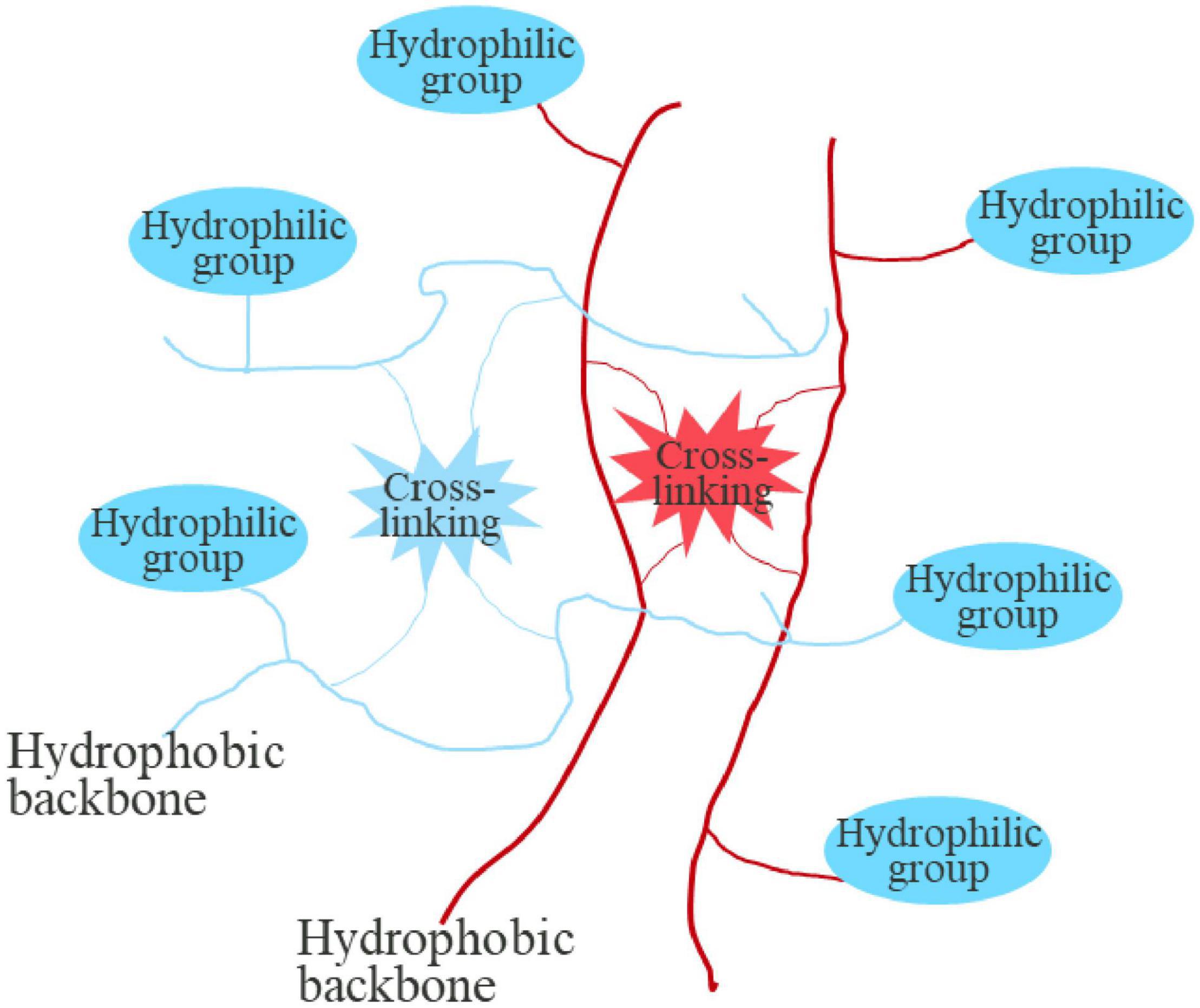
Figure 2. Schematic structure diagram of MCMC. Blue line, C–C molecular linking; red line, C–C molecular linking.
Soil for Test
The test soil was taken from a completely sandy grassland in Tangke Township, Ruoergai County, Sichuan Province (102°33′0.31″E,33°19′51.33″N). The annual rainfall of Zoige grassland is about 600 mm, and the area of existing desertification is 8.03 × 104 ha. Before the relevant tests, the retrieved soil samples were placed in a ventilated and dry place indoors for natural air drying. After semi-drying, large lumps were crumbed and the residual roots of plants were removed. After complete air drying, the soil samples were screened with a 2-mm aperture sieve. After fully mixing, the sieved soil samples were put into waterproof plastic bags and stored indoors in a dry area for standby use. The particle distribution curve of the soil sample measured with an LS I3 320 laser particle size analyzer is shown in Figure 3, which is fine sand soil. The calculation and analysis of the test results show that the average particle size D50 of Ruoergai sandy soil is 0.168 mm, the uniformity coefficient Cu(D60/D10) is 1.67, the gradation coefficient Cg(D30)2/(D10D60) is 1.04, and the specific gravity is 2.635 g/cm3, so it belongs to the poorly graded soil.
Vegetation for Test
Elymus was used as a grass species in the test because it is a native plant of this area and a drought-tolerant plant commonly used in artificial grassland restoration, and its root systems are well developed with a strong ability to fix soil and can be purchased as a commercial grass seed. The seeds used in this article were purchased from Beijing Millennium Dadi Grassland Ecological Technology Development Co., Ltd. (the seed germination rate measured in the indoor seed germination test can reach more than 95%). Before planting, all grass seeds should be soaked in water at room temperature for 1 h. The grass seeds should be sown on the surface of sand soil, and then a layer of loose fine sand with a thickness of 0.5 cm should be laid, which is wetted by water spray. The sowing density of grass seeds is 24 g/m2.
Sample Preparation
In this article, the root-fixed soil samples were prepared in the flowerpot. The depth of the flowerpot was 24 cm the diameter of the top is 22.5 cm, and the bottom hole allows free seepage. Permeable fibers, 2-cm-thick pebbles (particle size 0.2–0.5 cm), 5-cm base soil (natural fine sand), and 15-cm test soil layer were laid from the bottom to top, with a height of 2 cm reserved on the top.
Before sample preparation, the screened natural soil was put into the oven for drying at 30°C for 48 h (the microbial activity in the sample was retained), the sample was taken out and cooled to room temperature. First, the prepared MCMC and natural soil were evenly mixed according to the mass ratio of 1:4, and the control group was mixed with equal amounts of water and natural soil so that they can then be filled into the flowerpot according to the dry density of 1.45 ± 0.02 g/cm3 in layers. The thickness of each layer was 3 cm. The prepared samples were placed in a constant temperature plant cultivation room for breeding and subsequent index monitoring. During this period, the water supply was manually controlled. The water supply amount refers to the cumulative rainfall (about 400 mm) from April to October in Ruoergai. Water was supplied every other day in the first month, every 5 days in the second to fourth month, and every 7 days in the fifth to seventh month.
The total period of monitoring growth was 7 months, the collection interval was 30 days, and a total of seven collections were made. The monitoring indexes included plant growth and development characteristics and physical, chemical, and biological characteristics of root-fixed soil. The experimental groups added with MCMC were numbered as 0, 1, 2, 3, 4, 5, and 6#, respectively, according to the test time of 0, 30, 60, 90, 120, 150, and 210 days. The test sample, which was prepared using the same volume of water to replace MCMC to mix with soil and keep plant growth for 210 days, was named the control group (referred to as CK). Three groups of experiments in parallel were made for each treatment of sample.
Test Method
Determination of Plant Growth and Development Characteristics
The commonly used characteristic parameters of plant growth and development include total stem length (TLR), leaf width (WL), and plant aboveground biomass (PB). The plants with uniform plant distribution and good growth condition were selected as the measurement object, and at least five repetitions were ensured each time. Before collecting plants the sundries on the surface of the soil were first cleaned, and then the roots of the plants were aligned and cut to collect the aboveground parts of the plants. The test method of TLR was to measure the TLR of each plant from the ground to the leaves with an electronic Vernier caliper. The test method of WL was to measure the average WL of each plant with an electronic Vernier caliper. The test method of PB was to collect different parts of the plant and bake them in an oven at low temperature (60°C) for 72 h, and then measurements were taken after the quality became stable (Cornelissen et al., 2003).
Determination of Physical Parameters of Roots
Plant root characteristic parameters are closely related to soil mechanical strength and soil permeability coefficient. Common plant root characteristic parameters include root surface area index (RAI), root cross-sectional area ratio (RAR), and root volume ratio (Rv). Except for leaf area, all basic characteristic parameters directly depend on root growth morphological indexes.
The potted plant was inverted after cutting off the root, the silt attached around the root with small water flow was washed and dried at low temperature after cleaning, and the root was unfolded to shoot a full picture. Then, according to the natural extension state of the plant, samples were taken from three layers of 0–5, 5–10, and 10–15 cm along the depth direction. The root system of Elymus dahuricus Turcz with a diameter of 0.2–2 mm was investigated, and the characteristic parameters of the root system and the mechanical strength of the root system were measured.
Root Surface Area Index
The cleaned plant roots were measured using the image analysis method (Lopez et al., 2001; Zhou et al., 2021). In the measurement process, the overall 360° direction of the plant roots was photographed with a high-resolution camera, and then the images taken from different angles were superimposed to generate a three-dimensional complete root image through the image superposition processing method. Then, the three-dimensional root image was rasterized, the grid size was set, each grid was controlled to be the same as the picture’t pixels, the grids of all roots were accumulated in a specific depth, and the plant root area index was measured according to the conversion coefficient of 12 pixels per millimeter. The horizontal extension area of plant root system was calculated by measuring the maximum extension length of root system in the horizontal direction (Dr) as the diameter of horizontal cross section. RAI can be calculated as follows (Eq. 1):
where Δh is the specific depth calculated, generally taken as 10 mm, Dr is the maximum extension length of the root system in the horizontal direction, di is the diameter of the ith root system (mm), and n is the total number of roots.
Root Cross-Sectional Area Ratio
When measuring RAR, the root-taking method was the same as the above RAI, except that the depth was measured every 50 mm (Gray and Leiser, 1982). Vernier caliper was used to measure the diameter of plant root system on each depth section, and then statistical analysis was performed between zones at an interval of 0.5 mm (the root system with diameter less than 0.5 mm could be ignored due to its small proportion). The cross-sectional area of each root can be calculated on the assumption that the root is cylindrical. RAR can be calculated as follows (Eq. 2):
where Dr is the maximum extension length of roots in the horizontal direction, di is the diameter of the ith root (mm), and n is the total number of roots.
Root Volume Ratio
Using the image analysis method, that is, assuming that the plant root system is cylindrical, the root length and diameter measured by image analysis can indirectly calculate Rv. The calculation formula is as follows (Eq. 3):
where Dr is the maximum extension length of roots in the horizontal direction, di is the diameter of the ith root (mm), and n is the total number of roots.
Test of Physical Properties of Root-Fixed Soil
Mechanical Strength Test
The shear strength of root-fixed soil samples was measured using DJY-4 electric quadruple direct shear instrument. Root-fixed soil samples are semi-undisturbed soil taken from potted plants. The sampling method refers to the on-site sampling in the Standard for Geotechnical Testing method (GB/T50123-1999). In the direct shear test, four levels of vertical forward pressure of 50, 100, 150, and 200 kPa were applied to a group of four samples, respectively, and the strain rate of 0.8 mm/min used for rapid shear. The shear stress-displacement change curve at different times was monitored to obtain the shear strength t different times the horizont, the τ-P curve was drawn, and then the interfacial cohesion C and internal friction angle φ of soil were calculated.
Permeability Test
The sampling method refers to the mechanical strength sample. The undisturbed sample was air-dried at room temperature and cured for 28 days, vacuumized, and saturated. It was soaked in water for 24 h before the test. The permeability test device is South 55-type variable head permeability equipment, which is composed of permeability vessel (installing cylindrical sample) and head regulation device.
Test of Chemical Characteristics of Root-Fixed Soil
The content of nutrient elements such as water, carbon, nitrogen, phosphorus, and potassium in soil is the key to plant growth, which in turn affects the fixation of plant roots to soil, while plant growth also affects soil water and physical and mechanical characteristics. Therefore, the measurement indexes of soil physical and chemical properties include soil pH value, soil organic matter (SOM), total nitrogen (TN), available phosphorus (AP), available potassium (AK), carbon nitrogen ratio (C/N), and cation exchange capacity (CEC). Refer Table 2 for the test and analysis methods and some instruments of the above properties.
Test of Biological Characteristics of Root-Fixed Soil
The test of soil biological index has very high requirements for the preservation of samples before test and needs to be taken at any time. Biological characteristic indexes include microbial biomass carbon (MBC), microbial biomass nitrogen (MBN) of the sample and soil enzyme activity (sucrase, protease, urease, phosphatase, and catalase), and root-fixed soil enzyme activity is the reaction of soil biological activity and characterizes the change of soil fertility characteristics. The significance and analysis methods of each biological property index are shown in Table 2.
Analysis of Test Results
Basic physical, chemical, and biological characteristics of root-fixed soil with and without MCMC treatment in each event are shown in Table 3.
Plant Growth and Development Characteristics and Tolerance
Plant development characteristic parameters such as TLR, WL, and PB were tested, and the results are shown in Figure 4A. Seven months after planting, TLR, WL, and PB of plants in the experimental group and control group were 25.6 mm, 6 mm, and 6.27 g/m2 and 19.8 mm, 5 mm, and 3.93 g/m2, respectively. Compared with the control group, the stem length of the experimental group increased significantly, WL widened slightly, and PB increased by 59.65%, which indicates that MCMC could effectively promote the growth of plant stems and leaves. Monitoring the development characteristics of the aboveground parts of plants for 7 months, Figures 5, 6 show the lodging characteristics and drought stress monitoring results of plants within 1 and 3 months of growth, respectively. The results show that the lodging rate of the plants cultivated in the experimental group is reduced by more than 60%, and the survival rate of drought tolerance is increased by more than 80%. The results showed that MCMC soil enhanced the drought resistance and lodging resistance of plants, and ensured the root system to develop well in extreme environments.
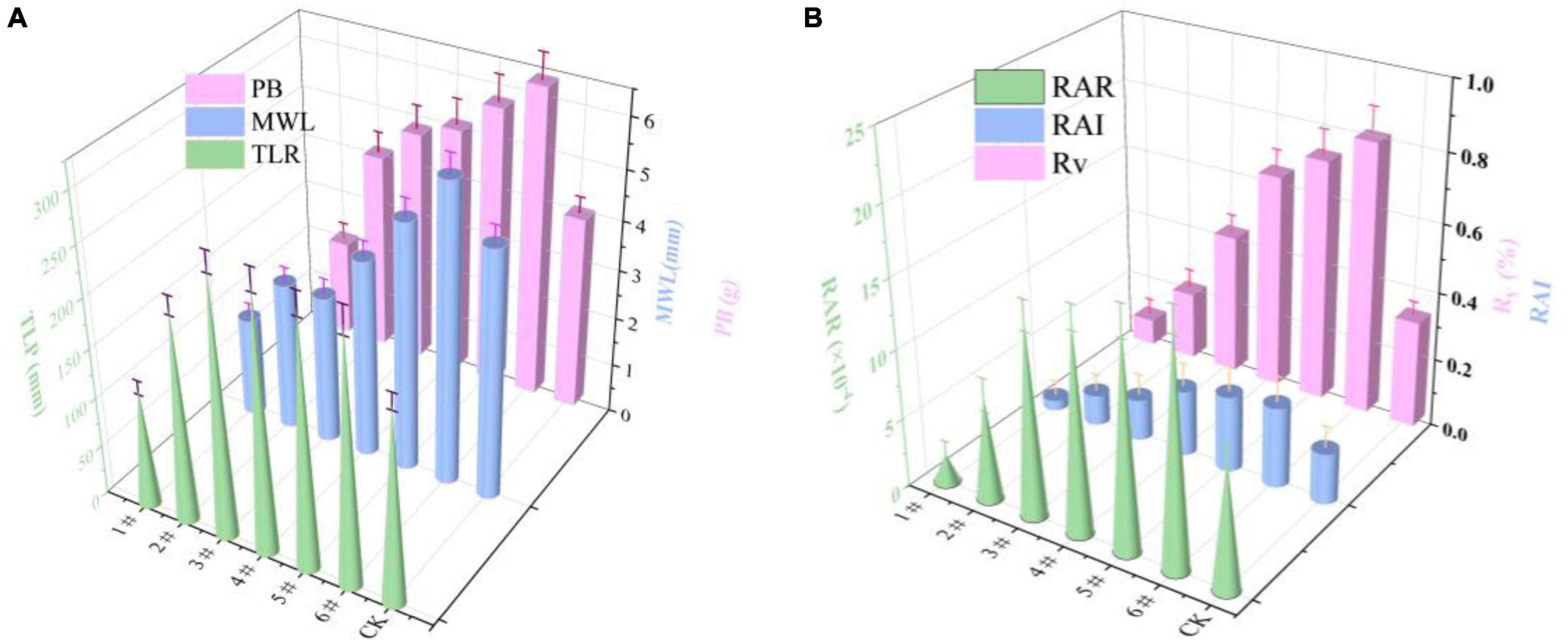
Figure 4. Characteristic parameters of vegetation. (A) Plant growth and development characteristics. (B) Development characteristics of plant roots.
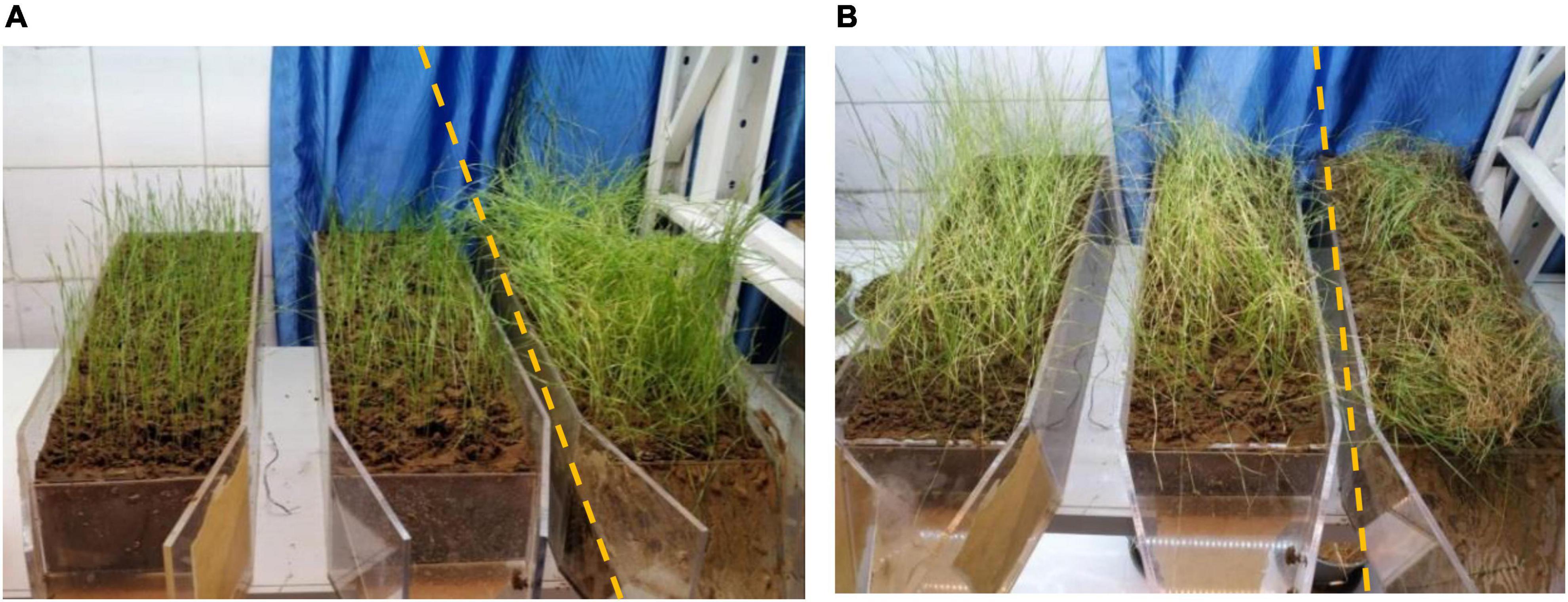
Figure 5. Plant growth status with and without MCMC at different times. (A) Plant growth 1 month (left, experimental group; right, control group). (B) Plant growth 1 month (left, experimental group; right, control group).
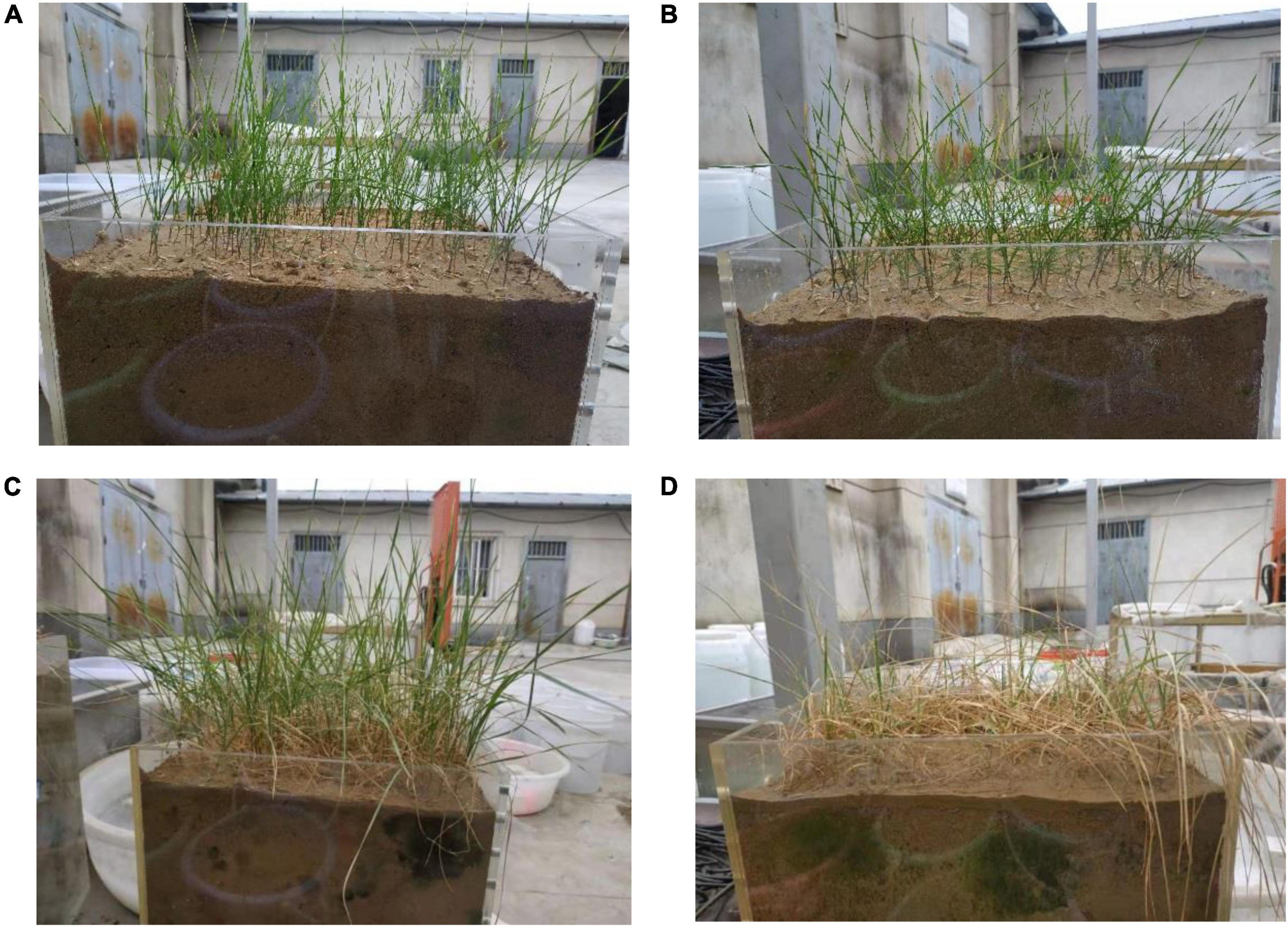
Figure 6. Observation of plant drought stress tolerance with and without MCMC at different times. (A) Experimental group after 1 month. (B) Control group after 1 month. (C) Experimental group after 3 months. (D) Control group after 3 months.
Development Characteristics of Plant Roots
The test results of characteristic parameters such as RAR, RAI, and Rv of plant roots are shown in Figure 4B. The plant root system of the control group and experimental group after 7 months is shown in Figure 7. The number and length of root system in the experimental group are significantly better than those in the control group. After 7 months of planting, RAR, RAI, and Rv of roots in the experimental group and control group were 17 × 10–4, 0.235, 0.798%, and 9.2 × 10–4, 0.148, and 0.314%, respectively. Compared with the control group, after MCMC treatment, the number of roots increased two times, and the characteristic indexes such as RAR, RAI, and Rv increased nearly one time, indicating that MCMC can effectively promote the development of plant roots and make plant roots grow coarser. Conversely, the good development of plant root system in the material soil is the basis of strengthening the fixation of root system to the soil.
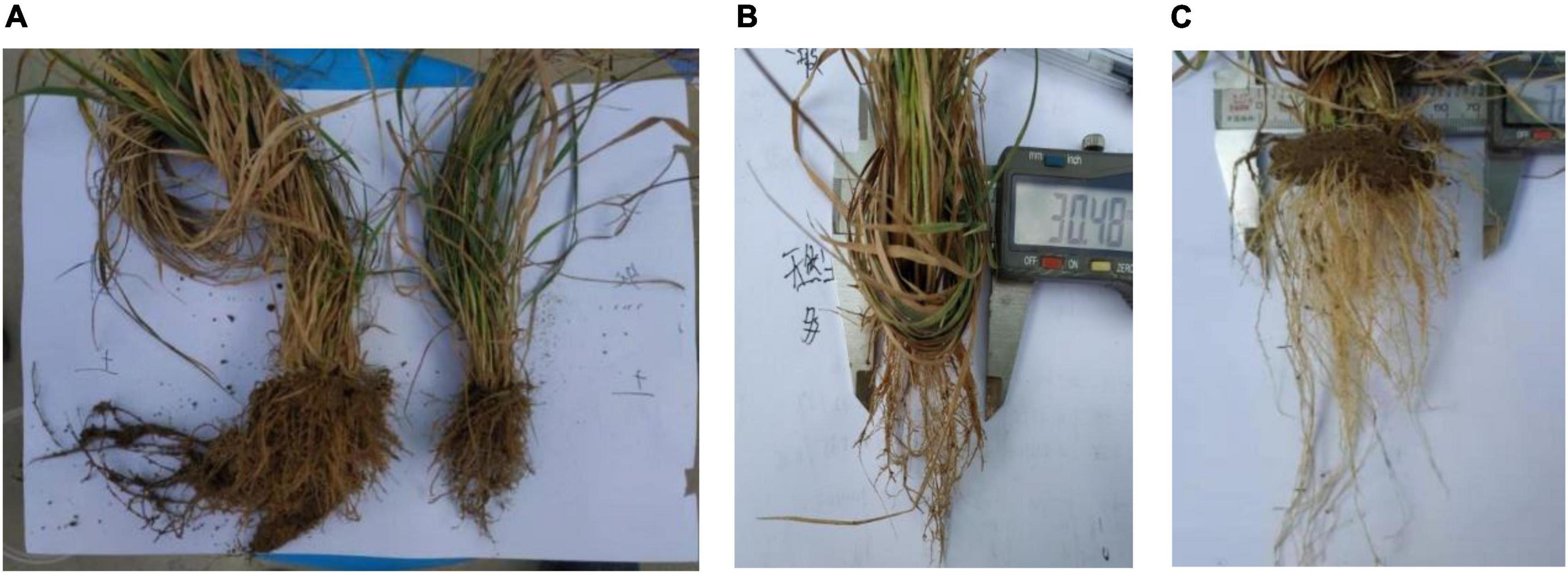
Figure 7. Plant root growth status with and without MCMC at different times. (A) The whole appearance of plant. (B) Control group. (C) Experimental group.
Basic Physical Properties of Root-Fixed Soil
The agglomeration of root-fixed soil in the experimental group is shown in Figure 8, and the basic physical properties are shown in Figure 9. After 7 months, the rhizosphere soil content, root-fixed soil content, and soil crust thickness of the experimental group were 1.84, 2.63, and 1.96 times that of the control group, respectively. The experimental results reveal that plant root systems have stronger network and soil particle fixation ability in MCMC-improved soil and can form the topsoil stable crust layer faster, thus strengthening the water stability of soil agglomeration.

Figure 8. Agglomeration of root-fixed soil reinforced with organic materials. (A) 1 month. (B) 3 months. (C) 7 months.
Chemical and Biological Characteristics of Root-Fixed Soil
The test results of the main chemical characteristics in root fixed soil are shown in Figure 10. With the growth of plants, it can be found that the pH value of root-fixed soil in the experimental group is always maintained between 7.5 and 8.0, while the contents of SOM, TN, AP, AK, and CEC gradually increase, indicating that the addition of MCMC reduces the pH value of natural soil, the nutrients in MCMC root-fixed soil are gradually accumulated, the fertilizer-holding capacity of soil is continuously enhanced, and the soil is gradually matured, which continues to develop in the direction conducive to plant growth. The chemical characteristics of root-fixed soil after 7 months of growth are shown in Table 3. The pH value of natural root-fixed soil is slightly alkaline, while the pH value of MCMC root-fixed soil is more neutral. Compared with the control group, soil nutrient indexes such as SOM, TN, and AP in the experimental group are significantly higher, while AK content is basically the same. At the same time, the C/N ratio of the control group was significantly higher than that of the experimental group, which will make the microorganisms in the soil to consume more nitrogen when decomposing organic matter, further reducing the nitrogen in the soil and causing nitrogen deficiency of plants.
Soil enzyme activity is often used to characterize the response of soil treatments to soil fertility levels and is a sensitive indicator of soil quality (Chen et al., 2003). Figure 11 shows the biological characteristic index of root-fixed soil after 7 months of growth. The invertase, protease, urease, phosphatase, catalase, MBN, and MBC in the experimental group and control group are 1.10 × 104 μg/g⋅2 h, 150 μg/g⋅48 h, 122 μg/g⋅24 h, 35.9 μg/g⋅h, 112 μg/g⋅20 min, 25.5, 194, and 1.35 × 104 μg/g⋅2 h, 200 μg/g⋅48 h, 122 μg/g⋅24 h, 17.8 μg/g⋅h, 128 μg/g⋅20 min, 22.0, 170, respectively. Compared with the control group, the content of sucrase reflecting soil biological activity and fertility in the experimental group increased by 22.73%, the content of protease reflecting the soil nitrogen source hydrolysis level increased by 33.33%, the content of urease-reflecting soil urea nitrogen hydrolysis level was the same, and the content of phosphatase, which reflects the decomposition level of soil organic phosphorus, decreased nearly double, so it can be seen that there is an obvious difference. This may be related to the pH value of the soil. Because the pH value of the control group and experimental group is greater than 7, it is alkaline, which inhibits the activity of acid phosphatase in the root-fixed soil, whereas the pH value of the control group is greater and the alkalinity is stronger, which will significantly enhance the activity of alkaline phosphatase in the soil. Catalase exists only in living cells and is a direct characterization of microbial activity (Skujiņš and Burns, 1976), whereas the catalase content of the experimental group increased by 14.29%, which directly indicates that there are more microorganisms and stronger activity in the experimental group. The above analysis results show that the addition of MCMC enhanced soil enzyme activity, significantly increased the content of soil nutrients, significantly accelerated the transformation and accumulation of nutrient elements, and significantly increased the number of microorganisms, which fully proves the enhancement effect of MCMC on plant root-fixed soil “maturation.” The MBN and MBC indexes related to soil-available nutrients are also higher, indicating that the effective nutrients of the experimental group are better than the control group as a whole. MCMC contributes to the transformation and enrichment of soil nutrient elements, enhances the nutrient cycle in the soil, and increases the soil-available nutrients that can be used for plant growth.
Discussion
Quantitative Strengthening Model of Modified Carboxymethyl Cellulose-Reinforced Sand
Root system can improve the properties of MCMC root-fixed soil. In addition to the agglomeration, permeability, and mechanical strength of MCMC root-fixed soil, the fertility level in soil will also change during root growth and development (Minh et al., 2003; Nghiem et al., 2004; Xiao et al., 2011). Aggregation (f1) is characterized by rhizosphere soil, which is the stable part of root-fixed soil, permeability (f2) is characterized by the cumulative change of permeability coefficient, and mechanical strength (f3) is characterized by the cumulative change of cohesion and internal friction angle. Since the root system has no obvious effect on the internal friction angle of the material reinforced soil, f3 is only characterized by cohesion. The organic matter (SOM) in the soil can be transformed into nutrients for plant absorption through the decomposition of soil microorganisms, which promotes the growth and development of plants. At the same time, it can also affect soil structure, aeration, permeability, adsorption, and buffering. Within a certain content range, the content of organic matter in soil was positively correlated with soil fertility level, so soil fertility (γ) can be comprehensively characterized by SOM content.
Figure 12 shows the changes in cohesion and permeability coefficient of MCMC root-fixed soil in 7 months. The dry mass of MCMC root-fixed soil increases the most. With the development of root system, the cohesion increases by 177% and the permeability coefficient decreases by 78% at most. It shows that in the process of plant root development the content of MCMC root-fixed soil increases linearly with the increase in growth time, the permeability coefficient decreases exponentially, and the cohesion increases linearly. A quantitative description model of soil reinforced by MCMC in the process of root growth and development was established.

Figure 12. Physical properties of MCMC root-fixed soil. (A) Rhizosphere soil change of MCMC root-fixed soil. (B) Cohesion change of MCMC root-fixed soil. (C) Permeability coefficient change of MCMC root-fixed soil. (D) SOM content change of MCMC root-fixed soil.
The relational expression between the enhancement change of various performance indexes of MCMC root-fixed soil and the plant growth and development time can be corrected as follows:
where f is the change percentage of each index parameter, and x is the plant growth and development time.
It was assumed that the outdoor plants grew for 6 months and the old roots did not decay while the new roots were generated the next year. With t representing the number of days, according to the relationship between the indoor MCMC root-fixed soil performance index enhancement percentage and plant growth time (4–7), the relationship between the outdoor MCMC root-fixed soil performance index enhancement percentage and plant growth time is as follows :
As natural cementation material, the content of SOM has a positive impact on the shear strength, aggregation, and permeability of the soil itself (Li et al., 2016). Therefore, the soil maturation index γ should also be considered in the calculation of the root-strengthening effect of different characteristics of MCMC root-fixed soil. γ is related to the soil classification standard of each region in the national soil census table and is specified in combination with the soil fertility status of each region. Assuming that the comprehensive root strengthening index is F(t), then
where δi is the weight value of influence of MCMC root-fixed soil aggregation, cohesion, internal friction angle, and permeability coefficient on root soil reinforcement, and γ represents the soil maturation coefficient, which is a constant.
Mechanism and Ecological Significance of the Modified Carboxymethyl Cellulose Plant Root Succession Soil Fixing on Alpine Grassland Restoration
MCMC adsorbs water molecules with long molecular chain interwoven soil particles-polar functional groups, which greatly enhances the ability of soil water retention and evaporation reduction, enhances the drought resistance and lodging resistance of plants, and makes plants survive the most difficult seedling stage. Moreover, MCMC can make the root system and plant develop better, the physical properties such as the rhizosphere soil, root-fixed soil, and soil crust thickness are gradually strengthened, the nutrient contents such as SOM, TN, AP, AK, and CEC are gradually increased, and the pH, cohesion, and permeability coefficient of root-fixed soil are gradually improved. Although MCMC is gradually deteriorated with the influence of environmental factors and the soil consolidation effect is weakened, the soil consolidation effect of roots is gradually enhanced with the growth and development of root system in order to realize the successive soil consolidation method of “tradeoff” and “complementary advantages” by using MCMC plant roots.
In conclusion, this article summarized the process mechanism of soil fixation by MCMC plant roots according to the schematic diagram shown in Figure 13. The first is the initial use of MCMC-stabilized soil-fixing effect to protect the normal growth of plants. In the medium term, after the reinforcement effect of MCMC was reduced, the soil-fixation effect of the root system was enhanced to maintain the material-root soil joint reinforcement and ensure the normal succession of plants. In the later stage, the soil-fixation effect disappeared with MCMC degradation, and the soil-fixation effect of mature plant roots played a major role. When the soil between roots is basically transformed into rhizosphere soil, that is, the properties of soil, including matter, chemical and biological aspects are comprehensively improved, that is, the stable soil fixation of natural plants, the succession of MCMC and plant roots, and the long-term stable ecological restoration of sandy land. As shown in Figure 14, a desertification grassland on Lhasa treated by MCMC from 2017 to 2020 verified the abovementioned laws.
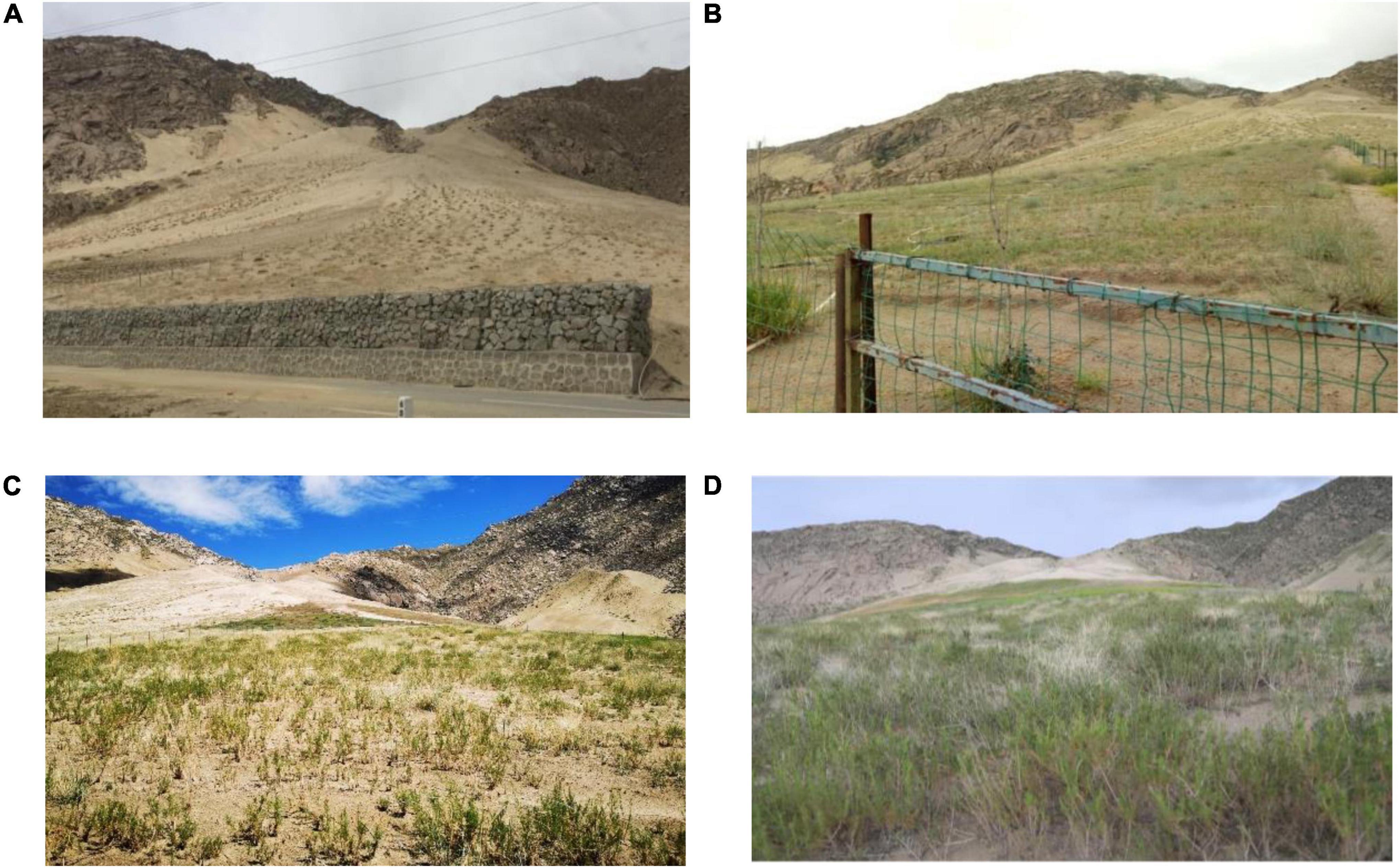
Figure 14. The restoration effect of a desertification grassland on Lhasa treated by MCMC from 2017 to 2020. (A) Filmed in the summer of 2017. (B) Filmed in the summer of 2018. (C) Filmed in the summer of 2019. (D) Filmed in the summer of 2020.
However, the quantitative evaluation of the MCMC aging process and its characteristics of reducing evaporation and water conservation to enhance the drought tolerance of plants needs further study.
Conclusion
1. In the experimental group compared with the control group, plant biomass increased by 59.65%, the lodging rate of plants decreased by more than 60%, the survival rate of drought tolerance increased by more than 80%, RAR, RAI, and Rv increased one time, and the number of plant roots increased two times. It is shown that the addition of MCMC significantly enhanced the drought tolerance and lodging resistance of plants, ensured the root system developed well in an extreme environment, and made plants grow better.
2. The rhizosphere soil mass, root-fixed soil mass, and soil crust thickness of the experimental group were 1.84, 2.63, and 1.96 times that of the control group, respectively. It is indicated that the addition of MCMC can effectively fix the soil particles, promoting the formation of a stable topsoil crust faster and strengthening the water stability of soil agglomeration, which accelerated the maturation of sandy soil.
3. On the one hand, MCMC enhanced the water retention and evaporation capacity of sandy soil, helping plants to pass through the most difficult seedling stage. On the other hand, MCMC improved soil cementation structure, improved soil physical, chemical, and biological properties, and jointly promoted plant and root development. With the weakening of the MCMC soil-fixing effect, the effect of root soil fixing was gradually enhanced, and the organic agent-plant root succession soil fixing was established to realize grassland restoration.
Data Availability Statement
The original contributions presented in the study are included in the article/supplementary material, further inquiries can be directed to the corresponding author/s.
Author Contributions
QY: conceptualization, data curation, and writing-original draft. XP: funding acquisition, supervision, and project administration. CF: formal analysis, investigation, writing-review, and editing. All authors contributed to the article and approved the submitted version.
Funding
This study was partially supported by the Postdoctoral Foundation of China (No. 2020M683272) and the National Science Foundation of China (Nos. 41931296 and 41907254).
Conflict of Interest
The authors declare that the research was conducted in the absence of any commercial or financial relationships that could be construed as a potential conflict of interest.
Publisher’s Note
All claims expressed in this article are solely those of the authors and do not necessarily represent those of their affiliated organizations, or those of the publisher, the editors and the reviewers. Any product that may be evaluated in this article, or claim that may be made by its manufacturer, is not guaranteed or endorsed by the publisher.
References
Cao, J. J., Li, G. D., Adamowski, J. F., Holden, N. M., Deo, R. C., Hu, Z. Y., et al. (2019). Suitable exclosure duration for the restoration of degraded alpine grasslands on the Qinghai-Tibetan Plateau. Land Use Policy 86, 261–267. doi: 10.1016/j.landusepol.2019.05.008
Chen, S. K., Edwards, C. A., and Subler, S. (2003). The influence of two agricultural biostimulants on nitrogen transformations, microbial activity, and plant growth in soil microcosms. Soil Biol. Biochem. 35, 9–19. doi: 10.1016/S0038-0717(02)00209-2
Cornelissen, J. H. C., Lavorel, S., Garnier, E., Díaz, S., Buchmann, N., Gurvich, D. E., et al. (2003). A handbook of protocols for standardised and easy measurement of plant functional traits worldwide. Aust. J. Bot. 51, 335–380. doi: 10.1071/BT02124
Cui, S. H., Pei, X. J., Jiang, Y., Wang, G. H., Fan, X., Yang, Q. W., et al. (2021). Liquefaction of Bedding Fault Material: a possible reason for the initiation of rapid movement of Daguangbao Landslide Triggered by the 2008 Wenchuan earthquake (Ms 8.0). Eng. Geol. 295:106455. doi: 10.1016/j.enggeo.2021.106455
Deng, L., Zhang, Z., and Shang, G. Z. (2014). Long-term fencing effects on plant diversity and soil properties in China. Soil Tillage Res. 137, 7–15. doi: 10.1016/j.still.2013.11.002
Dong, S., Shang, Z., and Gao, J. (2020). Enhancing sustainability of grassland ecosystems through ecological restoration and grazing management in an era of climate change on Qinghai-Tibetan Plateau. Agric. Ecosyst. Environ. 287:106684. doi: 10.1016/j.agee.2019.106684
Duan, M. J., Gan, Z. B., Guo, J., Gao, Q., and Wan, Y. (2016). Effects of Fertilization on Plant Diversity and Productivity of Alpine Meadow in Northern Tibet. Acta Agric. Boreali-Occidentalis Sin. 25, 1696–1703.
Gravuer, K., Gennet, S., and Throop, H. L. (2019). Organic amendment additions to rangelands: a meta-analysis of multiple ecosystem outcomes. Glob. Change Biol. 25, 1152–1170. doi: 10.1111/gcb.14535
Gray, D. H., and Leiser, A. T. (1982). Biotechnical slope protection and erosion control. New York: Van Nostrand Reinhold.
Harris, R. B. (2010). Rangeland degradation on the Qinghai-Tibetan plateau: a review of the evidence of its magnitude and causes. J. Arid Environ. 74, 1–12. doi: 10.1016/j.jaridenv.2009.06.014
He, Y., and Kusiak, A. (2017). Performance assessment of wind turbines: data-derived quantitative metrics. IEEE Trans. Sustain. Energy 9, 65–73. doi: 10.1109/TSTE.2017.2715061
Li, H., He, Y., Xu, Q., Deng, J., Li, W., and Wei, Y. (2022). Detection and segmentation of loess landslides via satellite images: a two phase framework. Landslides 19, 673–686. doi: 10.1007/s10346-021-01789-0
Li, S. H., Wang, X. Q., Bao, Y. F., and Yin, S. L. (2016). Variability of Soil Properties under Different Vegetation Plots in Alpine Sandy Land. Chin. J. Soil Sci. 47, 60–64.
Li, X. R., Jia, X. H., and Dong, G. R. (2006). Influence of desertification on vegetation pattern variations in the cold semi-arid grasslands of Qinghai-Tibet Plateau, North-west China. J. Arid Environ. 64, 505–522. doi: 10.1016/j.jaridenv.2005.06.011
Liu, Y. Y., Wang, Q., Zhang, Z. Y., Tong, L. J., Wang, Z. Q., and Li, J. L. (2019). Grassland dynamics in responses to climate variation and human activities in China from 2000 to 2013. Sci. Total Environ. 690, 27–39. doi: 10.1016/j.scitotenv.2019.06.503
Lopez, B., Sabate, S., and Gracia, C. A. (2001). Vertical distribution of fine root density, length density, area index and mean diameter in a Quercus ilex forest. Tree Physiol. 21, 555–560. doi: 10.1093/treephys/21.8.555
Minh, N. Q., Nakamura, H., and Shiraki, K. (2003). Analysis of root reinforcement at slip surface. J. Japan Landslide Soc. 40:S49. doi: 10.3313/jls.40.4_302
Nghiem, Q. M., Nakamura, H., and Shiraki, K. (2004). Slope stability of forested slopes considering effect of tree root and steel bar reinforcement. Landslides 41, 264–272. doi: 10.3313/jls.41.3_264
Ploughe, L. W., Akin-Fajiye, M., Gagnon, A., Gagnon, A., Gardner, W. C., and Fraser, L. H. (2021). Revegetation of degraded ecosystems into grasslands using biosolids as an organic amendment: a meta-analysis. Appl. Veg. Sci. 24, 1–15. doi: 10.1111/avsc.12558
Seahra, S. E., Yurkonis, K. A., and Newman, J. A. (2016). Species patch size at seeding affects diversity and productivity responses in establishing grasslands. J. Ecol. 104, 479–486. doi: 10.1111/1365-2745.12514
Skujiņš, J., and Burns, R. G. (1976). Extracellular Enzymes in Soil. CRC Crit. Rev. Microbiol. 4, 383–421. doi: 10.3109/10408417609102304
Sun, H. L., Zheng, D., Yao, T. D., and Zhang, Y. (2012). Protection and Construction of the National Ecological Security Shelter Zone on Tibetan Plateau. Acta Geogr. Sin. 67, 3–12.
Sun, J., and Wang, H. (2016). Soil nitrogen and carbon determine the trade-off of the above and below-ground biomass across alpine grasslands, Tibetan Plateau. Ecol. Indic. 60, 1070–1076. doi: 10.1016/j.ecolind.2015.08.038
Tan, K., Ciais, P., Piao, S., Wu, X., Tang, Y., Vuichard, N., et al. (2010). Application of the ORCHIDEE global vegetation model to evaluate biomass and soil carbon stocks of Qinghai–Tibetan grasslands. Glob. Biogeochem. Cycles 24, 1–12. doi: 10.1029/2009GB003530
Wang, C. T., Wang, G. X., Liu, W., Wang, Y., Hu, L., Ma, L., et al. (2013). Effects of establish-ing an artificial grassland on vegetation characteristics and soil quality in a degraded meadow. Isr. J. Ecol. Evol. 59, 141–153. doi: 10.1080/15659801.2013.863669
Wang, D. J., Zhou, H. K., Yao, B. Q., Wang, W., and Mao, Z. (2020). Effects of nutrient addition on degraded alpine grasslands of the Qinghai-Tibetan Plateau: a meta-analysis. Agric. Ecosyst. Environ. 301:106970. doi: 10.1016/j.agee.2020.106970
Wang, H. M., Sun, J., Li, W. P., Wu, J. B., Chen, Y. J., and Liu, W. H. (2016). Effects of soil nutrients and climate factors on belowground biomass in an alpine meadow in the source region of the Yangtze-Yellow rivers, Tibetan Plateau of China. J. Arid Land 8, 881–889. doi: 10.1007/s40333-016-0055-2
Wang, J. S., Zhang, X. Z., Chen, B. X., Shi, P., and Wu, J. (2013). Causes and Restoration of Degraded Alpine Grassland in Northern Tibet. J. Resour. Ecol. 4, 43–49. doi: 10.5814/j.issn.1674-764x.2013.01.006
Wang, Z., Zhang, Y., Yang, Y., Zhou, W., Gang, C., Zhang, Y., et al. (2016). Quantitative assess the driving forces on the grassland degradation in the Qinghai–Tibet Plateau, in China. Ecol. Inform. 33, 32–44. doi: 10.1016/j.ecoinf.2016.03.006
Wu, G. L., Liu, Z. H., Zhang, L., Chen, J. M., and Hu, T. M. (2010). Long-term fencing improved soil properties and soilorganic carbon storage in an alpine swamp meadow of western China. Plant Soil 332, 331–337. doi: 10.1007/s11104-010-0299-0
Wu, S. N., Zhang, X., Gao, X. X., Xu, Y. D., Wu, X. H., Shan, X., et al. (2019). Succession dynamics of a plant community of degraded alpine meadow during the human-induced restoration process in the Three Rivers Source region. Acta Ecol. Sin. 39, 2444–2453. doi: 10.5846/stxb201804070783
Wu, X. W., Wang, Y. C., and Sun, S. C. (2019). Long-term fencing decreases plant diversity and soil organic carbon concentration of the Zoige alpine meadows on the eastern Tibetan Plateau. Plant Soil 458, 191–200. doi: 10.1007/s11104-019-04373-7
Xiao, B. L., Luo, S. L., Deng, Y. S., Wu, W., and Zheng, J. Q. (2011). Research on Mechanism and Test of Roots for Ecological Slope. J. Hunan Univ. 38, 19–23.
Yang, Q. W. (2020). Research on the mechanisms of soil stabilization and slope ecological restoration during the succession process from modified organic stabilizer to plant root [D]. Chengdu: Chengdu University of Technology.
Yang, Q. W., Pei, X. J., and Huang, R. Q. (2019a). Impact of polymer mixtures on the stabilization and erosion control of silty sand slope. J. Mt. Sci. 16, 231–246. doi: 10.1007/s11629-018-4905-6
Yang, Q. W., Pei, X. J., and Huang, R. Q. (2019b). Research on the effect of freeze and thaw cycles on the property and damage mechanism of MCMC stabilized soil. Chin. J. Rock Mech. Eng. 36, 1–13.
Yang, Z. Z., Zhang, C. P., Dong, Q. M., Yang, X. X., Chu, H., Li, X. A., et al. (2018). Effects of Reseeding on Plant Community Composition and Diversity of Moderately Degraded Alpine Grassland in Qinghai-Tibetan plateau. Acta Agrestia Sin. 26, 1071–1077.
Zhan, T. Y., Hou, G., Liu, M., Sun, J., and Fu, S. (2019). Different characteristics of vegetation and soil properties along degraded gradients of alpine grasslands in the Qinghai-Tibet Plateau. Pratacultural Sci. 36, 1010–1021.
Zhang, Q., Ma, L., Zhang, Z. H., Xu, W. H., Zhou, B. R., Song, M. H., et al. (2019). Ecological restoration of degraded grassland in Qinghai-Tibet alpine region: degradation status, restoration measures, effects and prospects. Acta Ecol. Sin. 39, 7441–7451. doi: 10.5846/stxb201908301803
Zhang, X. Z., Wang, X. D., Gao, Q. Z., Hou, T. P., Shen, Z. X., and Fang, T. P. (2016). Research in ecological restoration and reconstruction technology for degraded alpine ecosystem, boosting the protection and construction of ecological security barrier in Tibet. Acta Ecol. Sin. 36, 7083–7087. doi: 10.5846/stxb201610172109
Zhou, H. K., Zhou, L., Zhao, X. Q., Liu, W., Yan, Z. L., and Shi, Y. (2003). Degradation process and integrated treatment of “black soil beach” grassland in the source regions of Yangtze and Yellow Rivers. Chin. J. Ecol. 22, 51–55.
Zhou, H. S., Yang, G. W., Liu, N., Kan, H. M., and Zhang, Y. J. (2014). Plant community and soil microbial characteristics in typical grasslands of different degradation degrees. Pratacultural Sci. 31, 30–38.
Zhou, J., Wei, J., Yang, T., Zhang, P., Liu, F., and Chen, J. (2021). Seepage channel development in the crown pillar: insights from induced microseismicity. Int. J. Rock Mech. Min. Sci. 145:104851. doi: 10.1016/j.ijrmms.2021.104851
Zhou, L., Zhang, D. G., Yun, X. J., Dong, Y. P., Wang, J. T., and Zhao, Y. L. (2016). The vegetation and soil haracteristics of degraded alpine meadow. Pratacultural Sci. 33, 2196–2201.
Zong, N., and Shi, P. (2019). Enhanced Community Production rather than Structure Improvement under Nitrogen and Phosphorus Addition in Severely Degraded Alpine Meadows. Sustainability 11:2023. doi: 10.3390/su11072023
Keywords: grassland degeneration, modified organic materials, improved sandy soil, succession fixed soil, plant root
Citation: Yang Q, Pei X and Fu C (2022) Effect of Polymer Mixtures on Physical-Chemical Properties of Sandy Soil and Plant Growth. Front. Ecol. Evol. 10:889357. doi: 10.3389/fevo.2022.889357
Received: 04 March 2022; Accepted: 30 March 2022;
Published: 06 June 2022.
Edited by:
Yusen He, Grinnell College, United StatesReviewed by:
Yi-Xiang Song, Hebei University of Technology, ChinaChao Huang, Kyoto University, Japan
Zhilu Chang, Nanchang University, China
Copyright © 2022 Yang, Pei and Fu. This is an open-access article distributed under the terms of the Creative Commons Attribution License (CC BY). The use, distribution or reproduction in other forums is permitted, provided the original author(s) and the copyright owner(s) are credited and that the original publication in this journal is cited, in accordance with accepted academic practice. No use, distribution or reproduction is permitted which does not comply with these terms.
*Correspondence: Xiangjun Pei, UGVpeGowMTE5QHRvbS5jb20=; Cheng Fu, RnVjaGVuZzE4NDgyMTc1NzIyQDE2My5jb20=
 Qingwen Yang
Qingwen Yang Xiangjun Pei
Xiangjun Pei Cheng Fu3*
Cheng Fu3*